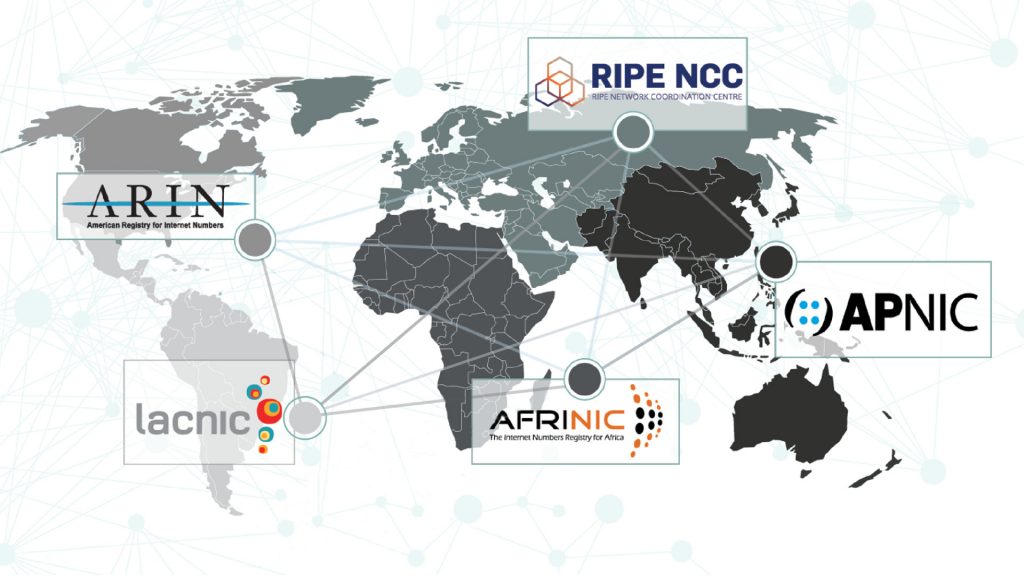RIR Transfer Policies
by IPv4.Global Staff

There are twice as many people on our planet as IPv4 addresses. Plus, each person with internet access is almost certain to use multiple IPv4 addresses. For instance, an address for a home connection, one for an office connection, and one for a mobile data service. Generally, for devices to connect they must do so using unique addresses. While the same address can be used privately at the same time on different networks, connecting such devices to one another doesn’t work.
The expansion in the base number of global internet users and in the number of internet devices that interconnect means many more IP addresses are needed than there are IPv4 addresses. The newer protocol, IPv6, was developed to respond to this problem.
The Market as a Solution
IPv6 is the long-term answer to the scarcity of IPv4 addresses. Adoption has been gradual, and Google measures that almost half of connected devices in 2024 use it. Without an urgent and compelling reason to use IPv6, IT departments and device makers tend to keep IPv4 addresses in use. And so, in demand. Markets offer network expansion without the adoption of IPv6 by way of IPv4 transfer marketplaces.
Computing was expensive and IPv4 addresses were free in the early days of the internet. So many networks got more addresses than they needed. Many of these organizations still have large blocks of unused IPv4 addresses. The Regional Internet Registries (RIRs) have policies enabling the transfer of addresses from those with more than they need to those who need more.
The excess inventory can be redistributed through the market. Companies with a need can buy addresses. All the RIRs (with the exception of AFRINIC) have inter-RIR transfer policies. APNIC and the RIPE NCC have especially flexible policies to support inter-region transfers. Note, however, that all four prohibit transfers to AFRINIC because that RIR does not reciprocate by permitting transfers out of the region.
What is an RIR?
Data is sent across the internet to IP addresses. If two organizations try to use the same IP addresses, they will each lose some traffic and get a lot of traffic they don’t want. This would be both a security and operations problem.
The RIRs were established to register which organization uses each block of IP addresses. Their focus used to be on distributing new addresses. But they now focus on data accuracy and managing transfers between organizations.
The RIRs’ Territory
The RIPE NCC is the RIR serving Europe, the Middle East, and parts of Central Asia. Its full name is Réseaux IP Européens Network Coordination Centre.
APNIC is the RIR serving the Asia-Pacific and its full name is Asia-Pacific Network Coordination Centre.
ARIN is the RIR serving Canada, the United States, and many Caribbean and North Atlantic islands.
LACNIC is the RIR serving Latin American and the Caribbean and its full name is Latin American and Caribbean Internet Addresses Registry.

Map showing the five RIRs’ service regions, published under a CC-BY-A license by the Number Resource Organization
All the RIRs implement policies developed by their communities. Everyone is free to participate in their communities and influence policy decisions. It is the RIR communities that have chosen to develop policies enabling address transfers. The differences between the policies reflect the different needs in each region.
What is a Transfer, Intra-RIR Transfer, and Inter-RIR Transfer?
A transfer changes the registered holder of the addresses. Transfers are generally permanent. Only the RIPE NCC supports temporary transfers in 2024. A permanent transfer is very similar to a sale while a temporary transfer is like a lease. Transfers change who has the right to manage the registration data for a block of addresses in an RIR’s database.
Important security services, like RPKI, build on the IP address registry data.
Inter-RIR transfers are transfers that occur across different RIRs, while intra-RIR transfers are transfers that occur within the same RIR. The former may be more difficult to conduct than the former, as there may be differing and perhaps opposing transfer policies between different RIRs.
Understanding Transfer Policies
So, how exactly do transfer policies work in their respective regions?
RIPE NCC
| Who | Neither sources nor recipients need to be members but should still have a non-LIR account with RIPE. Non-members must have an agreement with a sponsoring member. |
| Requirements | The RIPE NCC conducts due diligence checks. It reviews the transfer agreement before evaluating the needs basis of the request. |
| Size | /24 (256 addresses) is the minimum size for transfers. |
| Legacy IPv4 | Legacy (Historical) IPv4 addresses can be transferred and may retain their legacy status. |
| Fees | RIPE NCC does not charge a transfer fee but there must not be outstanding balances on the membership account. |
| Permanence | RIPE policy allows both permanent and temporary transfers. |
| Restrictions | Recipients of a transfer must hold the addresses for two years before transferring them away. |
| M&A | Transfer restrictions do not apply to transfers arising from corporate mergers or acquisitions. |
| Incoming | The source RIR must have a compatible policy. |
| Outgoing | The receiving RIR must have a compatible policy. |
ARIN
| Who | Recipients need to sign a service agreement with ARIN. ARIN will sign an NDA with you before you submit any confidential information to it. |
| Requirements | ARIN conducts due diligence checks. It reviews the transfer agreement before evaluating the needs basis of the request. |
| Size | /24 (256 addresses) is the minimum size for transfers. |
| Legacy IPv4 | Legacy (Historical) IPv4 addresses can be transferred but lose their legacy status. |
| Fees | ARIN charges a $500 transfer fee for the seller. The buyer must also pay a tiered fee starting at $187.50. |
| Permanence | ARIN only supports permanent transfers. |
| Restrictions | Organizations that are the source of a transfer may not request addresses for three years. |
| M&A | Transfer restrictions do not apply to transfers arising from corporate mergers or acquisitions. |
| Incoming | The source RIR must have a compatible policy. |
| Outgoing | The receiving RIR must have a compatible policy. |
LACNIC
| Who | Recipients in the LACNIC service region must be a LACNIC member. They can join a National Internet Registry if their country is served by one. (If they are members of an NIR, they don’t need to join LAC NIC.) |
| Requirements | The recipient of the transfer must get pre-approval from LACNIC . The pre-approval expires after 24 months. |
| Size | /24 (256 addresses) is the minimum size for transfers. |
| Legacy IPv4 | Legacy (Historical) IPv4 addresses can be transferred. |
| Fees | LACNIC charges US$1,000 for transfers smaller than a /19 (8,192 IPv4 addresses). They require a downpayment of UD$200. They charge $1,500 for transfers of /19 and larger. |
| Permanence | LACNIC policy does not support temporary transfers. |
| Restrictions | Addresses allocated by LACNIC or obtained through transfer must be held for three years before being transferred. |
| M&A | Transfer restrictions do not apply to transfers arising from corporate mergers or acquisitions. |
| Incoming | The source RIR must have a compatible policy. |
| Outgoing | The receiving RIR must have a compatible policy. |
APNIC
| Who | Recipients in the APNIC service region must become an APNIC member. They can join a National Internet Registry if their country is served by one. (If they members of an NIR, they don’t need to register with APNIC.) These are registries providing service in local languages. |
| Requirements | The recipient of the transfer must get pre-approval from APNIC. The pre-approval expires after 24 months. |
| Size | /24 (256 addresses) is the minimum size for transfers. |
| Legacy IPv4 | Legacy (Historical) IPv4 addresses can be transferred. |
| Fees | APNIC charges the recipient 20% of the membership fee attributable to the addresses being transferred. |
| Permanence | APNIC policy does not support temporary transfers. A proposal to allow them is being discussed. |
| Restrictions | Allocations from 103.0.0.0/8 must be held for five years before being transferred. There is no hold period for transfers from other blocks. |
| M&A | Transfer restrictions do not apply to transfers arising from corporate mergers or acquisitions. |
| Incoming | The source RIR must have a compatible policy. |
| Outgoing | The receiving RIR must have a compatible policy. |
Fees
IPv4.Global has created a Fee Calculator to make the ins and outs of determining fees easier.
For complete descriptions of fee schedules, click the appropriate link below.
Summary
All four RIRs implement similar policies. Each wants to ensure IP addresses are being used efficiently instead of lying unused. They have an incentive to be a good partner to both sources and recipients of transfers.
All require the recipient’s needs to be assessed before approving the transfer. This, and hold periods, are intended to reduce stockpiling.
The needs assessment is simple. But all the RIRs will look closely at documents provided as a part of their due diligence process. They will examine the chain of custody if a block of addresses has been transferred between companies in mergers or acquisitions. They will also look closely at the documents identifying the people signing agreements.
Business Implications for Sellers and Buyers
When an organization finds it has an excess of IPv4 addresses they can easily turn their surplus into income. Multiple transactions over time is not a problem as the administrative overhead for inter-RIR transfers is relatively low.
Both sellers and buyers have a larger market when they consider inter-RIR transfers.
Organizations with a growing subscriber base, or need for servers, want to control the addresses used for their services. Buying from other regions gives everyone more choice.